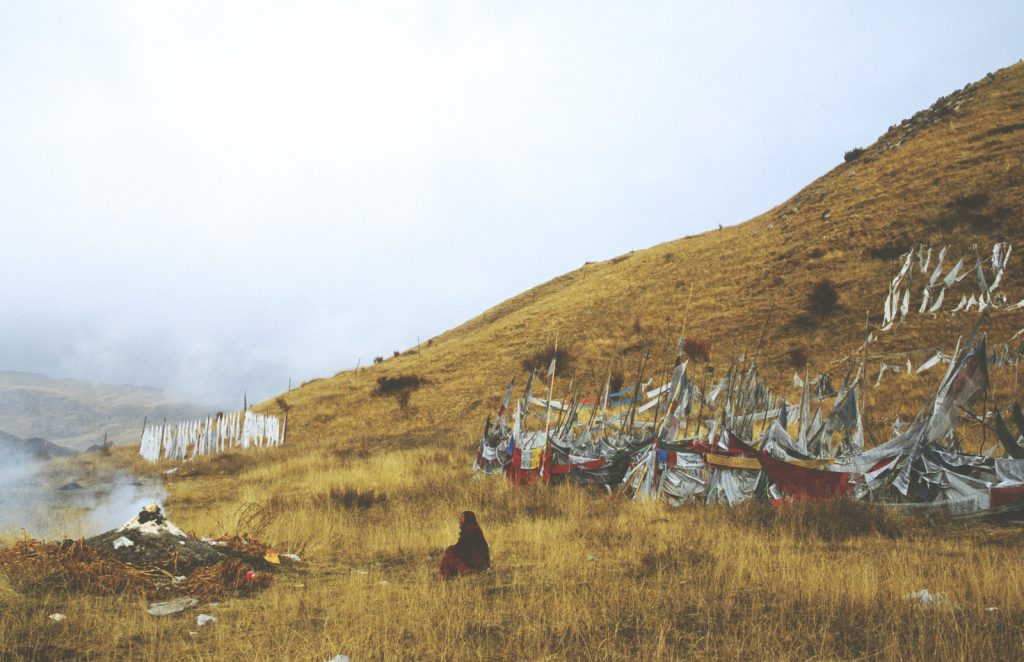Hey, noble one! Now you have arrived at what is called “death.” You are going from this world to the beyond. You are not alone; it happens to everyone. You must not indulge in attachment and insistence on this life. Though you are attached and you insist, you have no power to stay, you will not avoid wandering in the life cycle. Do not lust! Do not cling! Be mindful of the Three Jewels!
—Exhortation whispered into the left ear of the deceased
(The Tibetan Book of the Dead, trans. Robert A. F. Thurman)
Buddhist death rites vary widely by region, culture, class, school, and lineage, but certain elements prevail regardless of tradition: Even in countries where the mortuary industry holds sway, dead bodies are often dressed and attended by family and friends as a way of honoring and guiding the deceased and as a means for survivors to acknowledge the separation of body from the mind at death. Second, monks or other clergy—along with relatives—chant, recite, or otherwise offer goodwill and encouragement to the dead person to let go of worldly attachments, focus and pacify the mind, and incline toward an auspicious rebirth. Most Buddhist societies cremate their dead; the Buddha himself was cremated (though the corpses of his Indian contemporaries, for the most part, would have been left in charnel grounds), and his funeral set the standard for Buddhists through the coming millennia.
Theravada Buddhism
Theravada Buddhists dress the deceased in white (to symbolize virtue) and lay the body out for a vigil, often at home, during which monks are invited to chant and offer blessings. The dead person’s hand lies extended, and visitors pour a cup of water over the hand into a bowl of water in which blossoms float—a ritual for asking forgiveness for any transgressions against the person during her life. The deceased is then placed in a coffin that is sealed and carried to the cremation site, where monks will chant again. Just before the chanting begins, a designee knocks on the coffin and reminds the deceased to listen carefully to the words of Buddha’s teaching. A donor may place a small folded monastic robe on the coffin, as encouragement to propel the dead person successfully along on her journey, and before the cremation the robe cloth is donated to the monks. Immediately prior to being set afire, the coffin is opened, guests take a last look, and a coconut is broken and its water poured over the deceased as a final gesture of purification.
Related: Death is Not an Emergency
Tibetan Buddhism
In Tibet, and within Tibetan communities in exile, relatives and clergy keep vigil over the deceased for between four and nine days, during which a lama or adept reads from Liberation through Hearing During the Intermediate State, better known as The Tibetan Book of the Dead. The text guides the deceased through the passages and obstacles of the bardos, or in-between states (between death and rebirth). Then the body is washed and disposed of. Tibet is known for its sky burials: a corpse is taken to a special “burial” ground, ritually dismembered, and offered to birds of prey. When the body is picked of flesh, the bones are ground and mixed with grain meal and then offered again to birds. Tibetans also cremate the dead, but this practice often is reserved for incarnate lamas or for commoners during the winter months. The deceased is expected to take a new birth at the end of 49 days.
Chan/Zen Buddhism
As Chan Buddhism spread from China and Korea to Japan in the 6th century, so too did the practice of ordaining the deceased as a monk or nun to improve his or her chances of an auspicious rebirth or of reaching nirvana after death. Today such posthumous ordinations rarely occur, but wakes and funerals in Chan and Zen communities follow traditional lines. The family or mortuary washes the body, and relatives keep vigil for up to 24 hours. Priests chant from sutras during this time, and guests offer “condolence money” to the deceased’s family, a portion of which is returned as a gift to the guests. In many Zen funerals, cremation takes place the day after the wake, at which point a priest gives a Buddhist name to the dead person; this prevents the return of the deceased if his name is called and may be a vestige of the funerary ordination practice. After cremation, family members pick bones from the ashes and place them, from the feet on up, in a funerary urn, which is then placed in a family grave.
Related: Creating the New American Buddhist Funeral
Pure Land Buddhism
Before and after a death, chanting the name of Amitabha Buddha is the primary key to helping the deceased enter the Western Pure Land or heaven. Friends and family are directed not to touch, move, or disturb the body in any way for a period of 12 to 24 hours, and not to cry, talk, or smoke in the presence of the body, as this could distract the deceased from his journey and mire him in suffering. After the period of stillness and chanting, during which the subtle consciousness separates from the body, family members wash and dress the body and organize a simple, inexpensive funeral. Relatives eat only vegetarian food for the 49 days after a loved one’s death in order not to associate any suffering with the deceased’s voyage to the Pure Land.
Thank you for subscribing to Tricycle! As a nonprofit, we depend on readers like you to keep Buddhist teachings and practices widely available.
